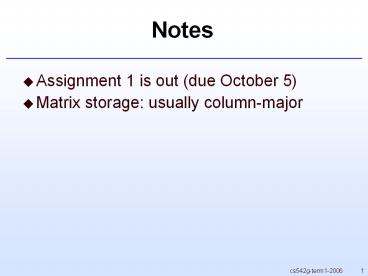Notes - PowerPoint PPT Presentation
Title:
Notes
Description:
Notes Assignment 1 is out (due October 5) Matrix storage: usually column-major – PowerPoint PPT presentation
Number of Views:27
Avg rating:3.0/5.0
Title: Notes
1
Notes
- Assignment 1 is out (due October 5)
- Matrix storage usually column-major
2
Block Approach to LU
- Rather than get bogged down in details of GE
(hard to see forest for trees) - Partition the equation ALU
- Gives natural formulas for algorithms
- Extends to block algorithms
3
Cholesky Factorization
- If A is symmetric positive definite, can cut work
in half ALLT - L is lower triangular
- If A is symmetric but indefinite, possibly still
have the Modified Cholesky factorization ALDLT - L is unit lower triangular
- D is diagonal
4
Pivoting
- LU and Modified Cholesky can fail
- Example if A110
- Go back to Gaussian Elimination ideas reorder
the equations (rows) to get a nonzero entry - In fact, nearly zero entries still a problem
- Possibly due to cancellation error gt few
significant digits - Dividing through will taint rest of calculation
- Pivoting strategy reorder to get the biggest
entry on the diagonal - Partial pivoting just reorder rows
- Complete pivoting reorder rows and columns
(expensive)
5
Pivoting in LU
- Can express it as a factorizationAPLU
- P is a permutation matrix just the identity with
its rows (or columns) permuted - Store the permutation, not P!
6
Symmetric Pivoting
- Problem partial (or complete) pivoting destroys
symmetry - How can we factor a symmetric indefinite matrix
reliably but twice as fast as unsymmetric
matrices? - One idea symmetric pivoting PAPTLDLT
- Swap the rows the same as the columns
- But let D have 2x2 as well as 1x1 blocks on the
diagonal - Partial pivoting Bunch-Kaufman (LAPACK)
- Complete pivoting Bunch-Parlett (safer)
7
Reconsidering RBF
- RBF interpolation has advantages
- Mesh-free
- Optimal in some sense
- Exponential convergence (each point extra data
point improves fit everywhere) - Defined everywhere
- But some disadvantages
- Its a global calculation(even with compactly
supported functions) - Big dense matrix to form and solve(though later
well revisit that
8
Gibbs
- Globally smooth calculation also makes for
overshoot/undershoot(Gibbs phenomena) around
discontinuities - Cant easily control effect
9
Noise
- If data contains noise (errors), RBF strictly
interpolates them - If the errors arent spatially correlated, lots
of discontinuities RBF interpolant becomes wiggly
10
Linear Least Squares
- Idea instead of interpolating data noise,
approximate - Pick our approximation from a space of functions
we expect (e.g. not wiggly -- maybe low degree
polynomials) to filter out the noise - Standard way of defining it
11
Rewriting
- Write it in matrix-vector form
12
Normal Equations
- First attempt at finding minimumset the
gradient equal to zero(called the normal
equations)
13
Good Normal Equations
- ATA is a square k?k matrix(k probably much
smaller than n) - Symmetric positive (semi-)definite
14
Bad Normal Equations
- What if kn?At least for 2-norm condition
number, k(ATA)k(A)2 - Accuracy could be a problem
- In general, can we avoid squaring the errors?































